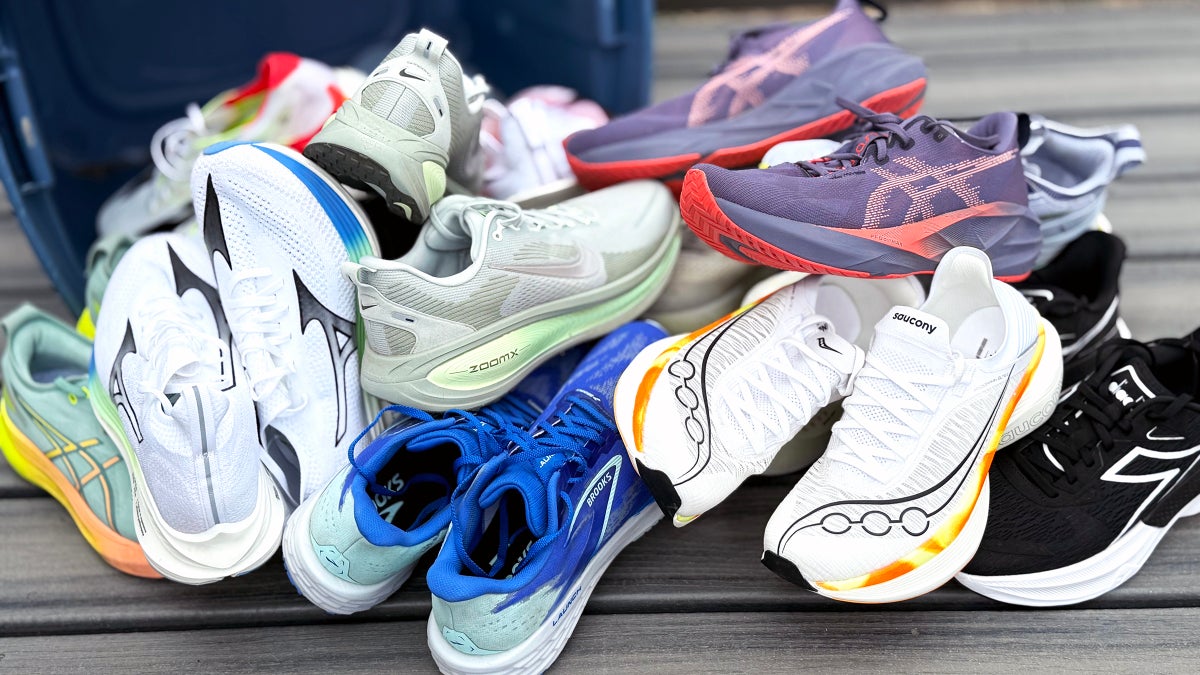
Running shoe technology is constantly evolving to meet the needs of the wide range of people getting out, gaining fitness, and pushing their personal limits. Today, the range of styles available to runners is greater than ever before, with shoe developers constantly introducing new foams and novel shapes, stack heights ranging from close-to-the-ground minimal to impossibly high maximal, and a smorgasbord of unique rides to complement any stride and preference.
A multitude of choices, however, can sometimes lead to decision paralysis. To help you find the best running shoe for your specific needs, we’ve tested more than 100 pairs of new and updated models with a diverse team of over 20 testers. Whether you’re seeking a speedy shoe to make you feel like you’re flying (and help you PR), or a daily workhorse that you look forward to lacing up, our guide is here to help.
Update March 2025: We’ve tested and selected new models in 11 categories, including a new best all-around pick of the Asics Novablast 5.
At a Glance
Training Shoes
- Best All-Around: Asics Novablast 5 ($140)
- Best Cushioned Trainer: Nike Vomero 18 ($150)
- Best Distance Trainer: Brooks Glycerin Max ($165)
- Best Value: Brooks Launch 11 ($120)
- Best Lightweight Trainer: Mizuno Neo Zen ($150)
- Best Super Trainer: Nike Zoom Fly 6 ($170)
- Best for Recovery Runs: Diadora Nucleo 2 ($160)
- Best Natural Ride: Mount to Coast R1 ($160)
Stability Shoes
- Best All-Around: Asics GEL-Kayano 31 ($165)
- Best Plush Stability: Puma ForeverRun Nitro 2 ($150)
- Best Lightweight Stability: Brooks Hyperion GTS 2 ($140)
Racing Shoes
- Best Marathon Racer: Nike Alphafly 3 ($285)
- Runner-Up Marathon Racer: Saucony Endorphin Elite 2 ($275)
- Best For Shorter Road Races: Adidas Adizero Adios Pro 4 ($250)
Trail Running Shoes
Tips and How We Test
Best Training Shoes
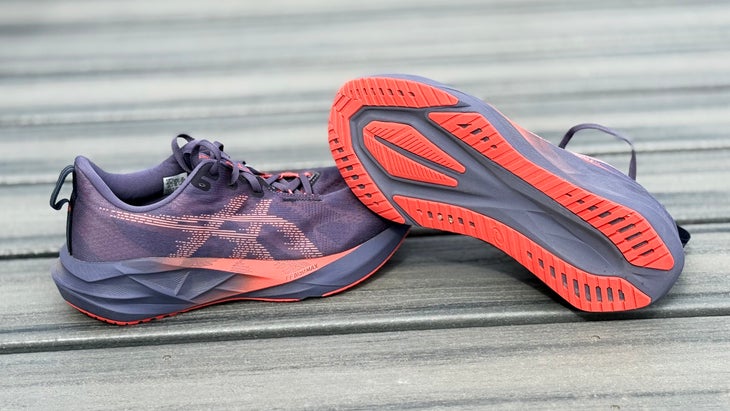
Best All-Around
Asics Novablast 5
$140 at Dick’s Sporting Goods $140 at Asics
Weight: 9 oz (men), 7.9 oz (women)
Stack Height: 41.5–33.5 mm (men’s); 40.5–32.5 mm (women’s)
Drop: 8 mm
Sizing: 6-13, 14, 15 (men’s), 5-12 (women’s)
Pros and Cons
⊕ Great weight-to-cushioning ratio
⊕ Smooth ride
⊗ Poor outsole grip in slick conditions
Versatile, cushioned, and responsive, few shoes check as many boxes as the ASICS Novablast 5. Underfoot, ASICS upgraded the midsole to FF Blast Max, a polyolefin-based compound that’s a touch softer and bouncier than its predecessor. Testers praised it for its “plush experience” and “lively and energetic feel underfoot.” The shoe delivers a buttery smooth ride with a noticeable poppy feeling most everyday trainers lack. Despite the thick stack of foam underfoot, the Novablast 5 remains surprisingly nimble for an everyday trainer. While it’s not our first choice for dedicated speedwork, it handles uptempo efforts better than any other daily trainer we tested. The ride is also surprisingly stable thanks to the wide base and the responsiveness of the foam, which saves it from feeling squishy.
The fit, which is true to size, remains largely unchanged from the Novablast 4. Testers appreciated the new stitch-free engineered jacquard mesh upper, noting it felt a touch softer, improving overall comfort. Straight out of the box, the Novablast 5 felt run-ready with no break-in required.
One area that could be improved is the outsole. In an effort to keep the weight down, ASICS skimped on the rubber. This didn’t affect traction on dry surfaces, but one tester noted that he lacked confidence in the shoe during cold and wet runs. “It’s not slick, but it doesn’t grip,” he said.
We rarely suggest one shoe that would work for every runner, but the ASICS Novablast 5 is a standout that just about anyone would appreciate for almost any type of run.
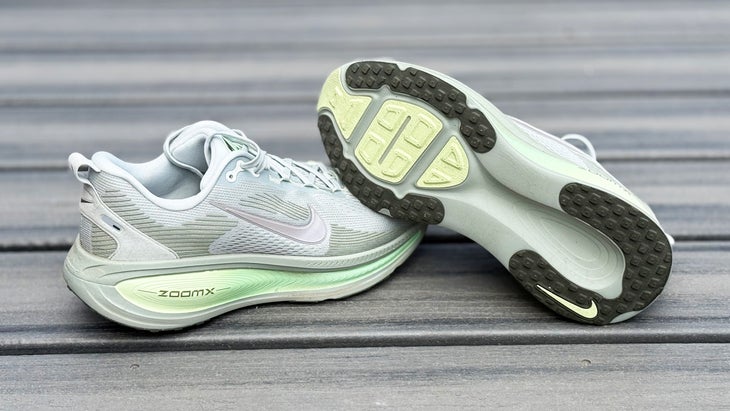
Best Cushioned Trainer
Nike Vomero 18
$150 at REI $150 at Running Warehouse
Weight: 11.5 oz (men), 9.3 oz (women)
Stack Height: 46–36 mm
Drop: 10 mm
Sizing: 6-13, 14, 15, 16, 17, 18 (men’s), 5-12 (women’s)
Pros and Cons
⊕ Outstanding stability for such a tall shoe
⊕ Extremely comfortable
⊗ Heavy, slow
When it comes to adding volume to running shoe midsoles, more isn’t always better. Sometimes more is just more. That’s not the case with the Vomero 18. With an added six millimeters of foam underfoot, everything about this shoe exudes comfort. Holding the title as Nike’s most thickly cushioned running shoe to date, the Vomero 18 features a dual-density midsole that pairs a new version of Nike React X—which Nike claims has 13 percent more energy return—with ZoomX foam. React X, the firmer, more durable layer, delivers structure and support on the bottom, while the softer, more responsive ZoomX—featured in Nike’s Alphafly and Vaporfly—sits on top for a bouncier ride. The pairing delivered a smooth, cushioned ride that testers found both plush and surprisingly stable for such a high-stack shoe.
Nike didn’t just add more cushioning underfoot—the revamped engineered mesh upper also receives a healthy dose of padding for all-day comfort. The downside to all this plushness is that the Vomero 18 tipped the scales at 11.5 ounces for men and 9.2 ounces for women, making it the heaviest shoe we tested. While they are well balanced and don’t feel like weights on your feet, testers did note the shoe is best suited for everyday, easy, comfortable runs.
Read our full wear-test review of the Vomero 18
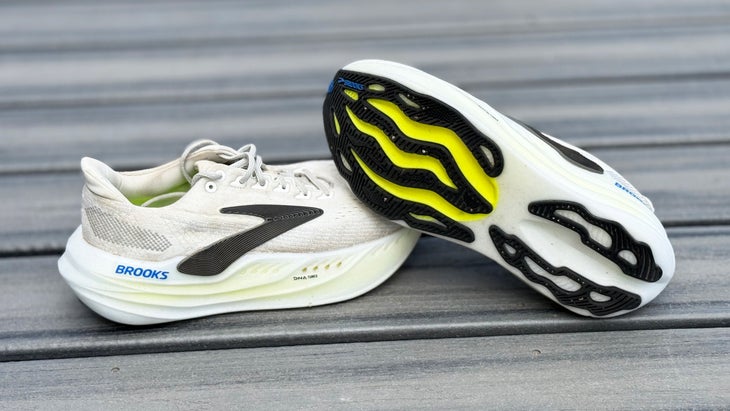
Best Distance Trainer
Brooks Glycerin Max
$200 at Running Warehouse $200 at Brooks
Weight: 10.5 oz (men), 9.5 oz (women)
Stack Height: 45–39 mm
Drop: 6 mm
Sizing: 7-13, 14, 15 (men’s), 5-12 (women’s)
Pros and Cons
⊕ Tuned midsole is both soft and responsive
⊕ Wide platform keeps tall midsole stable
⊗ Feels somewhat bulky
The Brooks Glycerin has long been Brooks’ premium highly cushioned everyday trainer. However, with stack heights increasing across the industry, its 38mm/28mm profile no longer stands out as a true max-cushioned option for long-distance running. Enter the Glycerin Max, which is Brooks’ highest-stacked shoe to date but manages to not feel overly tall.
Brooks’ new DNA Tuned midsole starts with its familiar nitrogen-infused EVA-based compound, but instead of being a consistent density throughout, the foam has different-sized cell structures in different locations, making it softer on the outside of the heel and firmer and more responsive on the inside of the heel and throughout the forefoot. “The result is a high-cushion shoe that I found doesn’t wallow and allows the foot to engage as it rolls through the stride, making it a shoe that I, usually a max-shoe hater, wanted to wear more,” noted one tester.
Raised sidewalls and a noticeably wide base aid in creating a stable stance for such a tall shoe. To enhance a smooth roll from an otherwise inflexible sole, a rockered forefoot encourages a natural forward transition, helping maintain momentum with each stride. A rather simple engineered mesh upper, consistent with other Brooks models, provides a true-to-size fit that complements the shoe’s plush underfoot feel. All in all, the Glycerin Max coddled our feet while rolling smoothly through the miles, making us want to keep going no matter how far from home we wandered.
Read our full wear-test review of the Glycerin Max
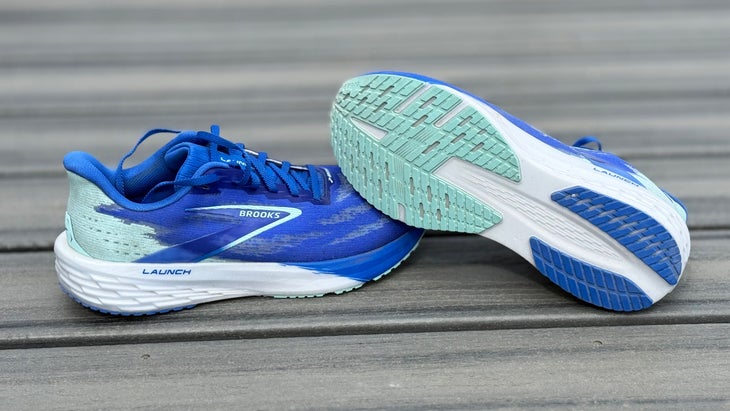
Best Value
Brooks Launch 11
Weight: 7.7 oz (men), 7.1 oz (women)
Stack height: 35.5–27.5 mm
Drop: 8 mm
Sizing: 7-15 (men’s), 5-12 (women’s)
Pros and Cons
⊕ A lot of bang for the buck
⊕ Foot-following fit and ride
⊕ Versatile
⊗ Narrow for some
It is not easy to find a good running shoe for less than 125 bucks these days, but the Brooks Launch 11 is an exception. The Launch 11 may not offer massive cushion or a carbon or nylon plate, but we kind of love that about it. Instead of the trampoline-like ride of so many other shoes on the market right now, the Launch 11 provides a classic, almost old-school vibe by allowing groundfeel while still offering a little bouncy rebound. Paired with an upper that conforms around and moves with your feet, plus looks great, we think this shoe gives a range of runners great bang for their buck.
With this update to the Launch, Brooks added 1.5 millimeters more lightweight, responsive cushioning (Brooks nitrogen-infused DNA Flash foam) under the heel and 2.5 millimeters more under the forefoot, with an insert of even lighter and springier DNA Flash 2. This gives the Launch 11 a higher stack height but a lower heel-toe offset (eight millimeters instead of 10) than the Launch 10. We found this update super comfortable and more than capable for everything from daily miles at a cruisy pace to shorter, faster efforts, and even allowed us to dance nimbly over tame trails. One tester noted that this shoe feels “light and springy and propels you forward,” while another called it “downright snappy.” Another tester gave the $120 Launch 11 a score of 10 out of 10, raving that it has “one of the best sneaker fits so far” for her narrow foot, with “all the bells and whistles needed.” Some other testers, however, found the fit too narrow.
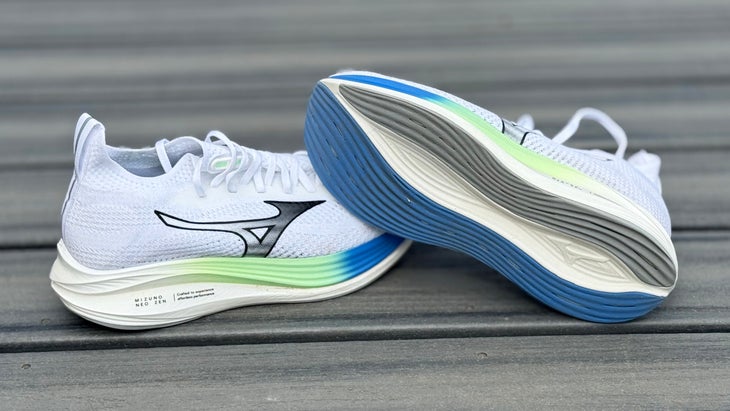
Best Lightweight Trainer
Mizuno Neo Zen
$150 at Running Warehouse $150 at Mizuno
Weight: 8.4 oz (men), 7.1 oz (women)
Stack Height: 39.5–33.5 mm
Drop: 6 mm
Sizing: 7-13, 14 (men’s), 6-12 (women’s)
Pros and Cons
⊕ Energetic midsole
⊕ Smooth, accommodating ride
⊗ Upper bunches for those with narrow feet
As the market has gravitated toward softer shoes, Mizuno—long known for its firm underfoot feel—has lagged behind. That is, until now. Testers were blown away by the comfort and smooth ride of the Mizuno Neo Zen. The standout feature? Its nitrogen-infused supercritical TPU midsole. “It feels completely different than anything out there. It is very soft but feels responsive when you get moving in it,” said one tester, while another added, “It’s soft enough to soak up impact on easy runs but has a propulsive energy return that makes picking up the pace feel effortless.” There’s no shortage of cushioning either with just under 40 millimeters of foam under the heel. Yet, despite all that foam, it remains impressively lightweight.
Ironically, given Mizuno’s history of using wave plates, the Neo Zen doesn’t have a plate embedded in its midsole like most super trainers. This contributes to the shoe having less of the trampoline-like bounce we’d like for race day, but it does offer an energetic feel for uptempo running and delivers a flexible, forgiving ride.
The upper features a stretchy, one-piece knit design that adapts to a variety of foot shapes and sizes. Often, a one-piece knit upper can be hit or miss, lacking the ability to wrap differently shaped feet securely. However, outside of some rippling across the forefoot when tied tight, testers were impressed by its sock-like fit and out-of-the-box comfort.
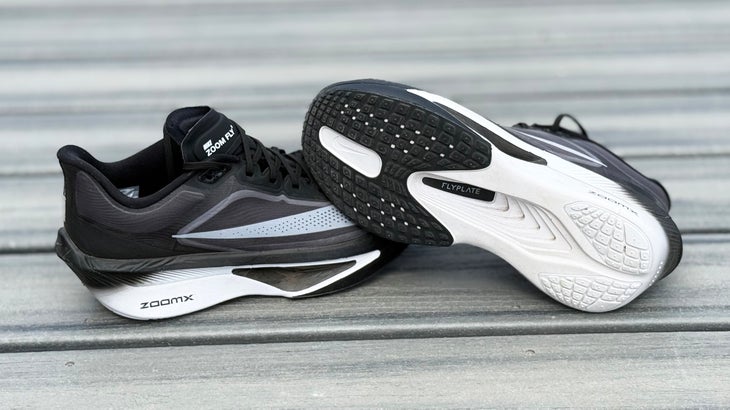
Best Super Trainer
Nike Zoom Fly 6
$170 at Backcountry $170 at Running Warehouse
Weight: 9.3 oz (men), 7.7 oz (women)
Stack height: 40–32 mm
Drop: 8 mm
Sizing: 6-15 (men’s), 5-12 (women’s)
Pros and Cons
⊕ Works for a variety of runners
⊕ Performs at a variety of paces
⊗ Can feel funky when heel striking
By definition, supertrainers combine racing technology with more durable elements. The Zoom Fly 6 borrows ZoomX, Nike’s premium Pebax midsole foam, from the lauded Vaporfly super shoe racer. But while the Vaporfly 3 (and Alphafly 3) are solely built with ZoomX cushioning, the Zoom Fly 6 adds a bottom layer of more stable and durable EVA foam, making it a daily trainer built to last day in and day out. The Zoom Fly 6 also has a wider profile to feel less tippy than the raceday rockets, and a lower stack height which allows greater connection to the ground.
While the previous version of the Zoom Fly could feel thick and chunky on the foot, the 6 is lean and streamlined. We found it felt light and fast on tempo runs or when doing speedwork, and stable and comfortable on longer, slower runs, although the heel-toe transition is less smooth when heel striking at an easy pace.
The carbon plate sandwiched between the two layers of foam, which feels slightly less rigid and aggressively rockered than that in the Zoom Fly’s racing siblings, seemed to stabilize the ride and save energy. The texturized rubber outsole does a great job gripping dry or wet roads, and even feels capable on smooth dirt. The woven mesh upper is comfortable and breathable, and the partially gusseted tongue cradles the foot. The Zoom Fly 6 feels capable and fun for daily miles, but is no slouch as a race-day choice either.
Runners who don’t want to fork more than $250 for a race-only super shoe may just fall in love with the Zoom Fly 6, as many of our testers did.
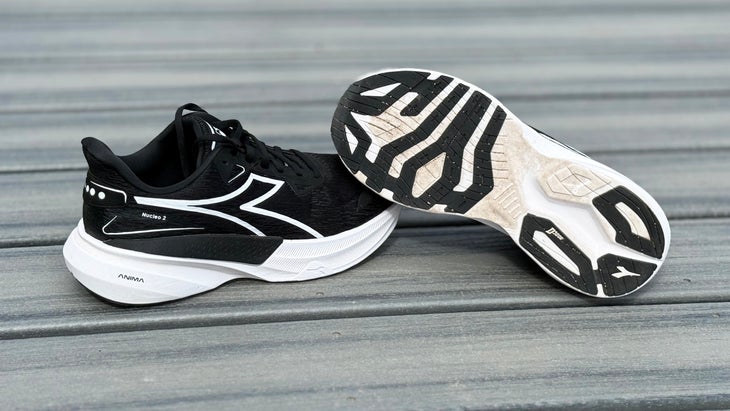
Best For Recovery Runs
Diadora Nucleo 2
Weight: 9.7 oz (men), 7.4 oz (women)
Stack height: 35–30 mm
Drop: 5 mm
Sizing: Men’s 7-15; Women’s 6-11.5
Pros and Cons
⊕ Good combo of cush and control
⊕ Comfortable upper
⊗ Tight across the toe box for wide feet
Yes, a shoe with a massive amount of soft cushioning can feel good underfoot for a cruisy run at an easy pace, but we think a comfy shoe with some stabilizing features works great for recovery. The Diadora Nucleo 2 is billed as a neutral trainer but has an updated heel counter that extends further towards the midfoot than the original Nucleo and provides some guidance to a tired stride. “The stiff heel counter makes me feel protected and stable,” said a tester. “It made me feel capable for a longer run.” We like how the cushioning from Diadora’s proprietary “Anima” foam absorbs impact without feeling squishy for runs where we just wanted to zone out, and we appreciated the outsole’s ability to keep us sure footed.
We also enjoyed how the outsole of this road shoe allows for a little exploring. It’s made out of the brand’s anti-abrasive rubber, and even offered grip on slippery roads with alternating snowmelt and ice. “I like that it has a little more traction than some shoes,” said a tester. “It can be used on road/packed trail, or road with imperfect conditions.” And the soft-yet-secure mesh upper with a nicely padded tongue and heel collar feels like a comforting hug—which is just what the doctor ordered after a day of hard training.
Read more about the Diadora Nucleo 2 in our stability shoe guide
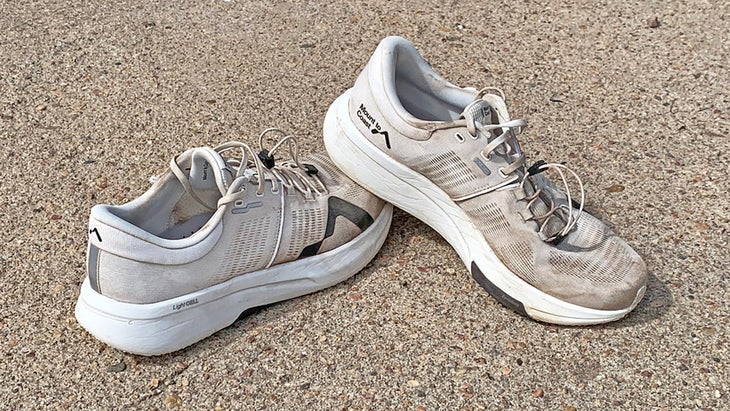
Best Natural Ride
Mount to Coast R1
Weight: 8.5 oz (men), 7.5 oz (women)
Stack Height: 35–27 mm
Drop: 8 mm
Sizing: 7-13, 14 (men’s), 6.5-11 (women’s)
Pros and Cons
⊕ Smooth ride,
⊕ Stable,
⊕ Adjustable lacing system
⊗ Not very cushioned
Hong Kong-based Mount to Coast may be new to the shoe scene, but it’s already making waves with its innovative approach to road running shoes. Marketed for ultra distance running, their debut shoe, the R1, is a medium stack height, everyday trainer with a suburb ground feel. One tester described the ride as “almost minimalist in allowing natural foot motion and sensitivity while dampening harsh landings.” The magic lies in the combination of a proprietary nitrogen-infused supercritical PEBA-blend midsole with an embedded S-shaped PU-based insert that extends from the lateral midfoot to beneath the big toe. Testers reported that the firmer insert provided a slightly more stable platform during the transition from landing to toe-off without any hint of control.
What’s really unique is the dual lacing system that features a traditional shoelace over the midfoot and a separate, quick-pull tie for the forefoot. This design lets you customize tension independently, ensuring a tailored fit for both areas. We loved how it allowed for a roomy fit through the toes with a secure midfoot lockdown.
Although Mount to Coast markets these as an ultra-distance shoe, we’d confidently recommend them as a daily trainer for runners seeking a touch of cushioning while maintaining a natural feel.
Read our full review of the Mount to Coast R1
Best Stability Shoes
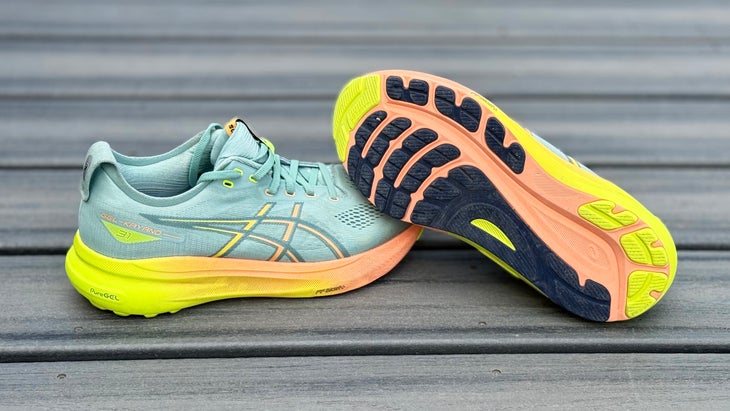
Best All-Around
Asics GEL-Kayano 31
$165 at Running Warehouse (Men’s) $165 at Running Warehouse (Women’s)
Weight: 10.7 oz (men’s), 9.2 oz (women’s)
Stack Height: 40–30 mm (men’s); 39–29 mm (women’s)
Drop: 10 mm
Sizing: Men’s 6-16; Women’s 5-13
Pros and Cons
⊕ Well-cushioned sole and upper
⊕ Smooth rolling ride
⊕ Stable without being firm or stiff
⊗ Somewhat heavy
Our testers were big fans of the Asics GEL-Kayano 30, which was a big departure from previous versions of the franchise shoe and a great example of how shoe companies have been rethinking traditional strategies to provide stability. The Kayano 31 built on the success of the 30, and we love it even more. “Since the Kayano is a stability shoe,” said a tester, “I expected it to feel harder. But I was very pleasantly surprised at the high level of cushioning.”
Like the 30, the 31 has a wide midsole and significant heel bevel, a flared sole under the forefoot, and soft, high-energy foam under the arch where we’re used to finding a firm medial post. Rather than attempting to block rotational movement, Asics says the bouncy insert, in combination with the shoes’ geometry, is designed to reduce the time at peak pronation and gently guide an over-rotating foot back into a more neutral position as it transitions from heel to toe-off.
The 31 boasts a new, engineered mesh upper that provides a great fit, regardless of foot shape. Testers loved how the upper “morphs” and “hugs” their feet, and raved about the plush comfort of the padded tongue and heel collar, as well as the cushioning underfoot. Also improved is the rubber outsole, which we found grippy on wet roads. This is a great update to an already reliable stability shoe that runs smoothly, responsively, and comfortably.
See our full round-up of stability shoes
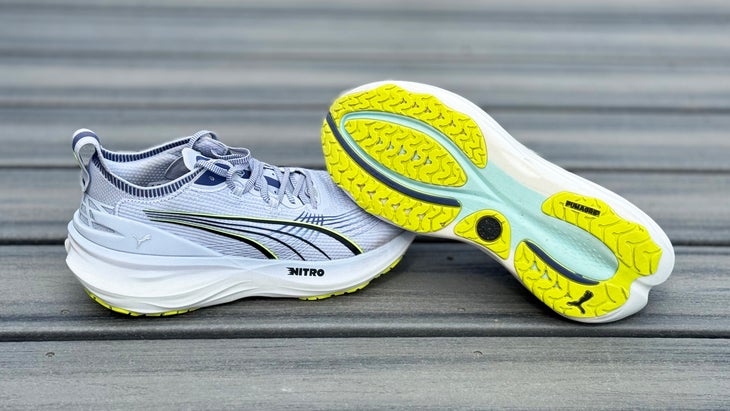
Best Plush Stability
Puma ForeverRun Nitro 2
$150 at Running Warehouse $150 at Puma
Weight: 10.4 oz (men), 8.1 oz (women)
Stack height: 38–28 mm
Drop: 10 mm
Sizing: 7-13, 14 (men’s), 6-11 (women’s)
Pros and Cons
⊕ Soft and smooth
⊕ Stable without feeling controlling
⊗ Toe box uncomfortable for some
The Puma ForeverRun Nitro 2’s significant stack of nitrogen-infused TPE foam underfoot and a wide forefoot silhouette make this feel like a lot of shoe. This thing is plush. But for that much cush this shoe comes in at a reasonable weight and offers a forgiving, comfortable ride.
Testers found the foam—a combination of a softer core surrounded by a firmer perimeter —to feel great underfoot, noting that the shoe ran “smooth and easy.” That’s not a description that comes easy for a stability shoe, and makes the ForeverRun Nitro 2 stand out. Complementing the underfoot cush is a premium engineered mesh upper that eliminates interior seams (aside from the partially gusseted tongue, which adds midfoot hold) to provide a welcoming step-in feel. The secure heel hold with a stabilizing external heel clip gives way to a narrow/secure-fitting midfoot, then splays out to a wide forefoot geometry that seems to add inherent stability throughout the gait cycle.
Despite the wide forefoot shape at the base, some testers craved more room on the interior, noting a feeling of crammed toes. But overall, the ForeverRun Nitro 2 is a great option for those seeking a combination of stability and cushioning in a good-looking shoe.
See our full round-up of stability shoes
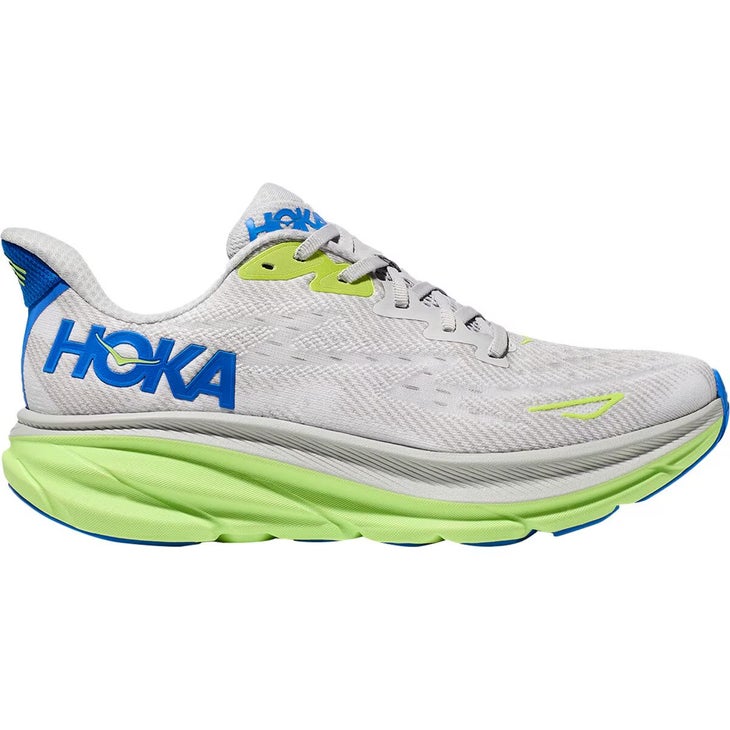
Paid Advertisement by Backcountry.com
HOKA Clifton 9 Running Shoe
Need a light, plush shoe for your everyday miles? Meet the HOKA Clifton 9. HOKA added more foam underfoot yet somehow dropped ounces to give increased shock absorption at a lower weight, making the ride smoother and your stride freer. The strategically placed rubber zones ensure this pair holds strong against the rigors of a daily trainer, while the articulated heel collar keeps you locked in mile after mile.
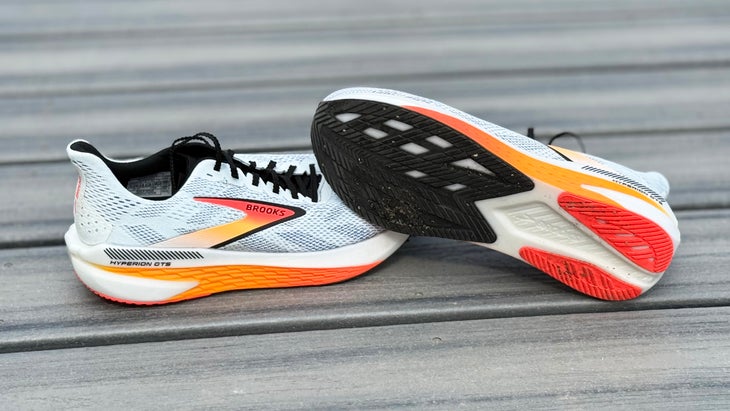
Best Lightweight Stability
Brooks Hyperion GTS 2
$140 at Running Warehouse $140 at Brooks
Weight: 7.6 oz (men’s), 6.9 oz (women’s)
Stack Height: 31.5–23.5 mm
Drop: 8 mm
Sizing: Men’s 7–15; Women’s 5–12
Pros and Cons
⊕ Lightweight
⊕ Low-profile, agile-feeling, and supportive ride
⊕ Highly breathable upper
⊗ Can feel too squishy in the heel for some
We loved the first-iteration Hyperion GTS for its lightweight comfort and springy, nitrogen-infused cushioning that one tester described as “fun and fast.” The second version is updated with a new midsole compound—nitrogen-infused DNA Flash v2—which Brooks says is lighter weight and more responsive than its predecessor. We concur—one tester described it as “snappy,” while another remarked on how it seems to push back while compressing and offers impressive rebound.
The GTS 2 still features stabilizing guide rails along the sides of the heel—a raised extension of the midsole foam on the outside, a firmer TPU piece on the inside—to help reduce heel shift and rotation for runners whose stride strays excessively inward or outward, especially towards the end of their run as a result of fatigue.
We appreciated the feeling of support while still being able to run smoothly and speedily when we wanted to up the effort. “I’d definitely speed train in these,” said a tester. “They’re responsive, nimble, and light.” These shoes are ideal for any runner looking for a daily trainer or racer that gives them a connected ground feel without being minimal. The cushioning is noticeable and lively, while the stability features are discreet. “I found these easy to run in at any speed,” said one. “They’re very responsive to whatever I feel like doing in them.”
See our full round-up of stability shoes
Best Racing Shoes
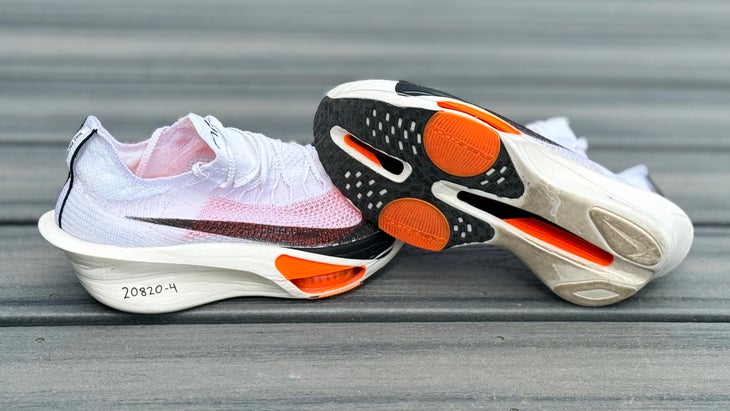
Best Marathon Racer
Nike Alphafly 3
$285 at Running Warehouse $285 at Dick’s Sporting Goods
Weight: 7.8 oz (men), 6.2 oz (women)
Stack Height: 40–32 mm
Drop: 8 mm
Sizing: 6-15 (men’s), 5-12 (women’s)
Pros and Cons
⊕ Bouncy, trampoline-like ride
⊕ Works for a wide range of runners
⊕ Lighter weight than previous versions of the AlphaFly
⊗ Heel can feel unstable
⊗ Can be hard to find in specific sizes
We’ve run in all three versions of the AlphaFly to date and think this third iteration is a great update. Subtle adjustments to the shoe’s geometry, including a wider footprint and carbon fiber plate, paired with repositioned Air Zoom units and strategically sculpted midsole, give the Alphafly 3 a distinctly different feel from its predecessor, which many found heavy and clunky compared to the original. This shoe again feels bouncy, fun, and fast.
Complementing the cush and rebound of ZoomX (Pebax) foam and Air Zoom units (pockets of compressed air and tensile threads) is a full-length carbon fiber plate that gives the shoe extra snap and adds a touch of appreciated stability that even the most efficient runners can benefit from when fatigued (marathon, anyone?). One of our more competitive testers praised the Alphafly 3 for its bouncy, energy-saving ride and says she’ll wear no other shoe for races longer than 10 miles. Another speedy tester noted, “Even running as fast as 5k pace, I found the Alphafly responded quickly, encouraging a fast turnover.” Some slower runners noted, however, that landing on the Alphafly’s sculpted heel can create a feeling of instability until the plate is engaged at the midfoot roll.
The upper of the Alphafly 3 is a lightweight, super-breathable mesh with an integrated tongue and thin, notched laces that pull tight and stay tied. Our feet were comfortable and secure without any pressure points on top of the ready-to-fly platform. We love that this shoe got lighter than its previous versions, which adds to its race-readiness.
Read our full review of the Alphafly 3. See our showdown comparison of 16 super shoes.
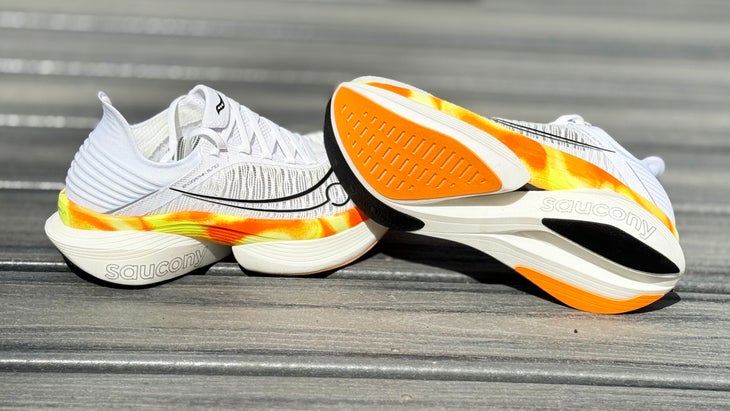
Runner-Up Marathon Racer
Saucony Endorphin Elite 2
$275 at Running Warehouse $275 at Saucony
Weight: 7.0 oz (men)
Stack height: 39.5–31.5 mm
Drop: 8 mm
Sizing: 3.5-14 (men’s/unisex)
Pros and Cons
⊕ Fast and springy
⊕ Secure foothold
⊗ Slightly unstable
Talk about an overhaul. This second iteration of the Saucony Elite could not be more different than the first. The primary reason is the underfoot feel of Saucony’s new, proprietary midsole material made out of TPEE that they’re calling “IncrediRUN” foam. While the original Elite’s midsole felt moderately firm until compressed powerfully, the Elite 2’s midsole feels wildly squishy and unstable when walking or slow jogging in the shoe. But, as one tester noted, “Once I started to pick up the pace, the foam firmed up and became insanely responsive.” With a stack height that falls just within legal limits for a marathon-racing shoe, that massive amount of rebounding foam—combined with a carbon fiber plate that’s slotted in the forefoot for flexibility (the same plate as in the original Saucony Elite) and an aggressive toe spring—makes this shoe beg for speed.
The upper has also been drastically updated, and we dig it. A combination of knit and mesh plus an airy knit tongue makes the shoe highly breathable. Testers found the heel collar and areas underneath the TPU overlays a bit warmer, but loved the secure heel fit paired with a roomier toe box. This is a fast, fun, lively shoe for race day.
Fit notes: We found this shoe to run a bit short. Also, the heel collar comes up high enough that a longer-than-no-show sock is needed.
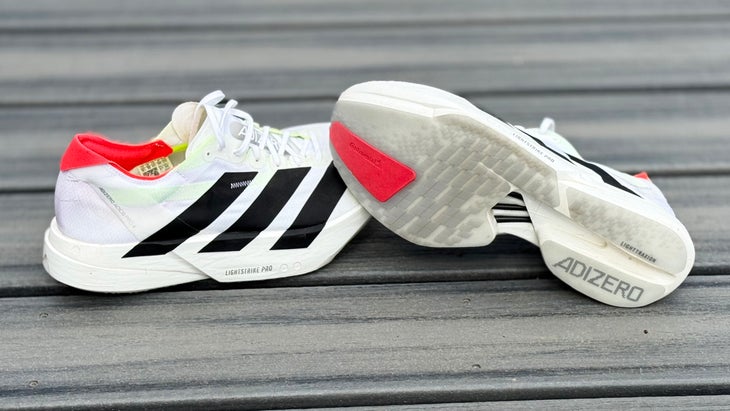
Best For Shorter Road Races
Adidas Adizero Adios Pro 4
$250 at Running Warehouse $250 at Dick’s Sporting Goods
Weight: 7.1 oz (men), 6.1 oz (women)
Stack Height: 39–33 mm
Drop: 6 mm
Sizing: 6-13.5, 14.5 (men’s), 5-12 (women’s)
Pros and Cons
⊕ Soft, bouncier midsole than previous versions
⊕ Great fitting, comfortable upper
⊗ Less stability and ground feel than previous versions
For short road races like the 5k and 10k you need a shoe that’s lively, explosive, and ready to roll. The new Adios Pro is all that. “Unlike the Pro 3, which felt more like a cruising shoe, the Pro 4 actively pushed you forward,” one tester remarked, adding that “it makes fast paces feel easier.” To achieve this, Adidas overhauled the Adios Pro 4 from top to bottom. Previously recognized as one of the firmer and more stable super shoes, it now joins the ranks of softer, bouncier super racers built for maximum cushioning and energy return. The newly formulated midsole is noticeably softer and bouncier.
Adidas’ signature energy rods are still embedded in the midsole, adding a bit of rigidity to the squish and roll. The start of the rocker, however, has been shifted backward, from 70 to 60 percent of the distance from heel to toe. When building their ultralight, high-performing race model, the Adizero Adios Pro Evo 1, Adidas’ designers learned that the longer rocker engages the foot earlier in the stride and benefits forefoot and midfoot runners, enabling a smoother transition from midfoot to toe-off. Testers noted the change, with one saying, “This shoe allows you to push off of your toe a lot easier than other shoes, which gives that fast feel.”
Substantial improvements were also made to the upper, which is now crafted of a one-way stretch-woven upper material that’s incredibly soft and form-fitting. Testers loved how it adapted to their foot’s shape, providing a secure, locked-in feel for total control. “The upper disappears on my foot in the best way possible,” remarked one.
“The Pro 4 is lighter, bouncier, and responsive than the Pro 3—a huge step up.” Unfortunately, those who liked the firmer, more stable and grounded feel of the Pro 3 may feel differently.
Read our full review of the Adidas Adizero Adios Pro 4
How to Choose a Running Shoe
When choosing a road running shoe, the first step is to determine the type of running you’ll primarily be doing in them. Do you need a speedy racer, a shoe that offers comfort during long, slow jogs, or a versatile trainer that can handle various distances and paces?
Next, consider your preference for the feel of the shoe’s cushioning: do you like a soft, forgiving ride, a more energetic, bouncy sensation underfoot, or a firmer platform that provides better ground feel? With advancements in foams and technologies, many shoes today offer cushioning without compromising responsiveness or stability. However, each shoe balances these characteristics differently, providing a spectrum of options to choose from. The key to finding the perfect running shoe is choosing the one you’re most comfortable with.
Once you’ve narrowed the search to a certain type of road shoe, you need to find a pair that complements your unique body and stride. Every runner’s body, gait, speed, experience, and ride preferences are different, so every runner will interact differently with each running shoe. The shoe that your best friend or your sister-in-law loves may be uncomfortable for you and make running feel slow, sluggish, or even painful. Finding the perfect pair of road running shoes is a seriously personal affair.
The process for choosing the best running shoes is a matter of finding the models that both fit your foot and also feel best when you’re running. To determine fit and feel, there’s no substitute for trying the shoes on and running in them.
Fit: Match Your Foot Shape
When assessing fit, first pay attention to length. You need room at the end of your toes as your feet lengthen during their dynamic movements on the run. A rule of thumb is to allow a thumb’s width between your longest toe and the end of the shoe. Runners often wear a running shoe a half or full size bigger than their street shoes.
Ensure that the shape of the sole and the upper matches your foot shape. The sole should be as wide or wider than your foot for the whole length, and match the curve of your arch comfortably. The shoe should hold your foot securely over the instep, while allowing the ball of the foot and the toes to splay and flex when you roll forward onto them. Your heel shouldn’t slip when you lift it, and the arch should be able to dome and lengthen naturally. Nothing should bind or rub as you roll through the stride.
Feel: Match Your Movement Path
If the shoe fits, it’s time to take them on a short run on a treadmill, around the store, or, ideally, down the block and back. Every running shoe has a unique ride created by the type and density of foam in the midsole and the geometry of that foam: its thickness, width, heel-to-toe drop, molded sidewalls or flares, and forefoot flexibility or rocker shape (plus, in an increasing number of models, the presence of and type of embedded plate). Each of these elements interact with each other and your stride to determine how the shoe reacts on landing, how much it cushions, how stably it supports, how smoothly it transitions from landing to toe off, and how quickly and powerfully it rebounds.
The best way to choose the shoes that complement your body and stride is to find the ones that feel right on the run. Benno Nigg, the world-leading biomechanics professor who proposed this method of shoe selection, calls it the “comfort filter,” but makes clear it is far more than how plush the shoe feels when you step into it. What you want to assess is whether the shoe allows and supports the way your feet want to move, what Nigg calls your “preferred movement path.” In the right shoe, while running at your normal pace, you will touch down where you expect to land, roll smoothly and stably through the stride without noticing the shoe, feel both cushioned from and connected to the ground, and push off naturally, quickly, and powerfully. When this comes together you’ll know that you’ve found your pair.
It’s likely that several shoes will feel good on your feet. To find the most comfortable, it helps to compare them back to back, like an eye doctor will do with corrective lenses: flipping between “A” or “B,” “1” or “2.” You may also find that different shoes feel better at different paces or level of fatigue, and you may want more than one pair. In fact, research shows that wearing a variety of different shoes is one of the few proven ways to reduce injury risk as it appears to vary the stresses on your feet and joints.
What About Injury Prevention?
Running shoes have long been marketed and sold as prescriptive devices to help runners stay healthy, but there is little scientific evidence correlating shoes, or any specific shoe properties—like cushioning or pronation control—with running injuries. Medical professionals say that it is highly difficult to determine whether a runner needs a certain type of shoe, and studies have shown that prescribing shoes using traditional methods like treadmill gait analyses or wet-foot arch height tests don’t consistently reduce injuries.
Don’t assume that you need more cushioning or more stability if you have sore joints, or if you’re a heavier runner, or if you’re a beginner—evidence doesn’t support many common beliefs. The best way prevent injury is find two or three different pairs that feel right on the run, ease into using them, and vary your shoes, your running surface and your pace regularly (plus avoid rapid increases in your training load and work on improving your mechanics).
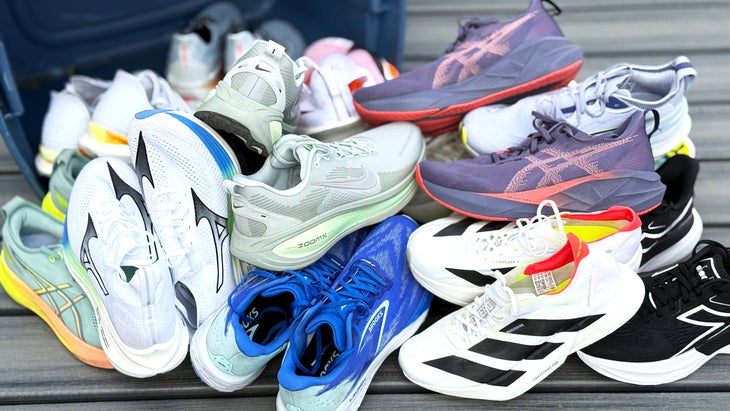
How We Test
- Number of testers: 27
- Number of shoes tested: 102
- Number of miles: 21,000+ over a year
To test running shoes, we begin by researching every brand’s upcoming offerings for the coming season. We wind up with dozens of samples of the models (40 road shoes this season, 102 over the year) that are most promising—not just for us, but for 27 testers that range in age, ability, running form, geographical location, and preferred shoe types. We try to put each tester in models from within the same category (e.g., neutral, stability, carbon fiber, zero drop or uptempo) so everyone can compare apples-to-apples.
After three to six months of running in each model on paved roads, concrete multi-use paths, treadmills, sandy beach paths, dirt roads, and tracks at a variety of distances, paces, and weather conditions, our crew members report back with their assessments of fit, comfort, traction, cushioning, flexibility, stiffness, pop, what type of running the model is best used for, how the shoe compares to other models, and more. We also run in every shoe ourselves, and, combining all the tester feedback with years of personal experience, hone in on the best. This guide combines the best recent shoes with outstanding shoes still available from the past two test periods.
Meet Our Lead Testers
Lisa Jhung
Freelance journalist, editor, and author Lisa Jhung has researched, tested, and written about running shoes for the past decade and a half, much of that time for Outside and Outside Buyer’s Guides. She coordinates a fleet of female shoe testers out of Boulder, Colorado, and says her home office is a perpetual obstacle course of cardboard boxes and piles of running shoes. Lisa’s written about gear of all kinds for numerous national magazines as both an editor and freelancer, including a stint as the Shoes & Gear blogger and trail running microsite editor for Runner’s World.
A high school jumper and occasional sprinter/hurdler, she started running—really running—after walking off the collegiate volleyball team, and moved on to road and trail races of any distance, triathlons, adventure races, and mountain running. She’s happiest testing rugged trail shoes on gnarly terrain, and also loves a good neighborhood jaunt…but is almost always looking for ribbons of dirt. Lisa is the author of Running That Doesn’t Suck: How to Love Running (Even If You Think You Hate It) and Trailhead: The Dirt on All Things Trail Running.
Cory Smith
Cory’s passion for running started over 30 years ago in high school when he became the number six ranked runner in the nation at 3000 meters his senior year. After high school, he competed at Villanova University, earning two NCAA Division I Championship showings. Today, he’s determined not to let age slow him down and competes on the national master’s circuit, running a 4:12 (4:30 mile pace)) 1500 meters and 9:04 (4:52 mile pace) 3000 meters in 2021 at age 43. He prefers a hard track workout or tempo run over an easy long run any day but also appreciates a challenging trail or mountain run.
His obsession with running shoes started in 2014 when he wrote his first shoe review for Gear Institute. Since then, he’s tested and reviewed hundreds of running shoes, clothing, and gear for Outside, Runner’s World, Footwear News, and other outlets. He has a soft spot for speedy shoes over heavy trainers but loves dissecting all shoes equally and thinking like a product engineer to explain the why behind every design detail. Cory is the Founder of Run Your Personal Best, an online running coaching business, and since its inception in 2014, has coached runners’ to over 100 Boston Marathon Qualifying times.
Here’s one of Cory’s shoe-testing routes on MapMyRun:
View Route Details
Create routes or search for a route at MapMyRun.
Jonathan Beverly
Jonathan fell in love with running his freshman year of high school and quickly became fascinated with finding the perfect pair of running shoes. That quest got a boost when he became editor of Running Times in 2000 and started receiving every new model as they were released. The parade of shoes continued while he served as shoe editor for Runner’s World, then editor of PodiumRunner, and currently fitness gear editor at Outside. Having now worn nearly every running shoe created in this century—and a fair amount of those dating back to the early models of the ’70s—he’s given up on finding the one best and now relishes the wide variety of excellent options.
Once a 2:46 marathoner regularly doing 50+ mile weeks, recent injuries and his age have reduced his volume by about half and slowed his easy training pace to around nine-minute miles—but he says he still enjoys an uptempo workout or two each week. Beverly is the author of the book Your Best Stride which explores how each individual’s gait—and thus shoe preference—is unique. He enjoys getting scientists’ take on new shoe trends and trying to describe the nuances of each shoe’s ride.
The post The Best Running Shoes for Training and Racing appeared first on Outside Online.















